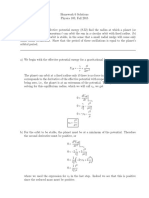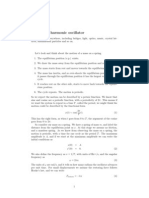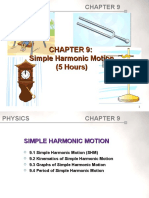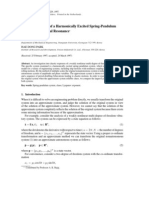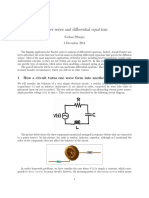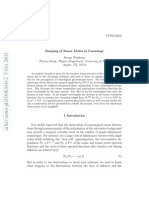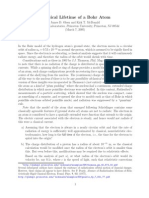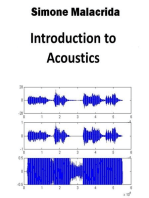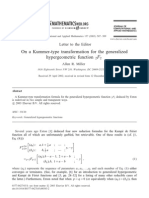Fiskom Chaotic Pendulum
Fiskom Chaotic Pendulum
Uploaded by
Wanda SuryadinataCopyright:
Available Formats
Fiskom Chaotic Pendulum
Fiskom Chaotic Pendulum
Uploaded by
Wanda SuryadinataOriginal Description:
Copyright
Available Formats
Share this document
Did you find this document useful?
Is this content inappropriate?
Copyright:
Available Formats
Fiskom Chaotic Pendulum
Fiskom Chaotic Pendulum
Uploaded by
Wanda SuryadinataCopyright:
Available Formats
ffi*
Chaos: Chaotic Pen dulum
6.L
Equation of Motion
We start from a simple pendulum. The equation of motion is given by
.&e :
*l#
-mgsrn9-
We consider the effect of air resistance on the motion of the ma.ss rn. We will
that the force of air resistance is given by Stokes' law. We get
*r# :
-mssin0-*ro#.
(6.1)
assume
(6.2)
The air friction will drain all enerry from the pendulum. In order to maintain the motion
against the da,mping effect of air resistance we will add a driving force. We will choose a
periodic force with amplitude mlFg, a,nd frequency u,ro. This arise for exarnple if we apply
a periodic electric field with arnplitude .Ep and frequency wD on the mass rn which is
assumed to have an electric charge q, i.e mlFp : eEo. It ca,n aJso arise from the periodic
oscillations of the pendulum's pivot point. By adding the driving force we get then the
equation of motion
*r# :
-rnssrl,e
- r'tlq# *
mlFpccxwl,t.
(6.3)
The natural frequency of the oscillations is given by the frequency of the simple pendulum,
viz
(rr0
(6.4)
"t
I
ydri et al, lectures on computational physics
48
We
will always take ar6 : 1, i.e. |
&0
:9.
The equation of motion becomes
Lde
(6.5)
dtz'Qdt
The coefficient Q :l/q is known as the quality factor. It measures how many oscillations
the pendulum without driving force will make before its enerry is drained. We will write
the above second order differential equation as two first order differential equations,
na,rnely
9:a
dt
:
dt - -1o
a"" -
!9
sino
Focosuot.
(6.6)
This system of differential equations does not admit a simple analytic solution. The
linear approximation corresponds to small amplitude oscillations, viz
sin0
(6.7)
0.
The differential equations become linear given by
ff:a
do1
dta
-:--
0-0+
Fncoswot.
(6.8)
+ Foenswnt.
(6.e)
.ior.t) u-& , ,* :
(6.10)
Or equivalently
692 t d0
w:-aa For Fp
e*
For ,[p
:0
the solution is given by
: (atoy coscu*t + 1(CI(0) . ffil
l0
a particular solution is given by
0*:
Fo(aenswr,t
* bsina.rgrt).
(6.11)
We flnd
a:
For ,t'p
l0
(L
w2)
,,u:
(1
,,r bt 2q
uD
(6.12)
the general solution is given by
0 - 0**0t'
(6.13)
ydri et aI, lectures computational physics
0t:
[(',', (6.14)
The last two terms depend on the initiat conditions and will vanish exponentially at very
large times t --+ oo, i.e. they are tra,nsients. The asymptotic motion is given by 0-.
Thus for, --+ oo we get
0 - 0*:
Also
Fo(acostopt
bsincupt).
(6.15)
(6.16)
for, *-+ oo we get
o_d0: fr,:
We compute in the
Foro(-asinwpt
limit of large times t -'+
bcosrupt).
o,+#:F'B-rflpz+ur:
*,fu
(6.17)
In other words the orbit of the system in phase space is an ellipse. The motion is periodic
with period equal to the period of the driving force. This ellipse is also called a periodic
attractor because regardless of the initial conditions the trajectory of the system will
tend at large times to this ellipse.
Let us also remark that the maximum angulax displacement is Fa. The function
Fo : Fo@p) exhibits resonant behavior as the driving frequency approaches the natural
frequency which is equivalent to the limit s;o --+ 1.. In this limit ,Fa : QFo.The width
of the resona,nt windovv is proportional to l/Q so for Q -+ oo we observe that f'r --) oo
when t.rp --+ 1 while for Q --r 0 we observe that Fp ---+ 0 when wxt ---+ L.
In general the timeasymptotic response of any linear system to a periodic drive
is periodic with the sa,rne period as the driving force. F\rrthermore when the driving
frequency approaches one of the natural frequencies the response will exhibits resonant
behavior.
The basic ingredient in deriving the above results is the linearity of the dynamical
system. As we will see shortly periodic motion is not the only possible time-asymptotic
response of a dynamical system to a periodic driving force.
6.2 Numerical
Algorithms
The equations of motion are
de
dr
d{t
dt
-r)
-f,A -
sin0 + F(r).
(6.18)
ydri et al, lectures on computational physics
The external force is periodic and
it will
be given by one of the following expressions
F(t):
FPcoswPt'
(6.1e)
F(t):
FPsinwPt'
(6.20)
8,2.L Euler-Cromer Algorithm
Numerically we c&n employ the Euler-Cromer algorithm in order to solve.this system of
differential equations. The solution goes &s followg. First we choose the initial conditions.
.
For exa,mple
Q(1):
0(1)
'(1)
Fori:1,...,N*lweuse
o(i + r)
o(i) +
:6
: o'
(6.21)
&(- *n,r, - sin0(i) + r(i))
: 0(i) + A' O(i + 1)
t(i+L):Lti'
0(i + L)
(6.22)
F(l;
: F(t(i)):
FDc(xuDAr(?
1).
(6.23)
F(i)
FDsinwoAr(i
1).
(6.24)
F'(r(i))
6.2.2 Runge-Kutta Algorithm
In order to
achieve better precision we employ
the Runge-Kutta algorithm. For
i:
1,...,ff*lweuse
h : A, O(i)
ks: Lt[*n,,, tz
k4
: a'[-
ar(o(c) +
*k
sino(i) +
r(i)]
*(",,. i*) -'in (ato. ]o) +rr;+ ])]
(6.25)
0(i+L):0(i)+kz
()(i + 1) : O(i) +,ta
,(i+1):Ati.
(6.26)
ydri et aI, lectures computational physics
F(i) = r(r(i))
F(a;
F(i +f,1 =
F(i
f'(r(i))
51
FD cosuDAr(d
1).
(6.27)
PasinaroAt(i
1).
(6.28)
rt ttl *f,oA :
+|l = rt
O)+
|at)
FDcosuDutrl
*).
Fo qina,o
*).
^t$
(6.2e)
(6.30)
6.3 Elements of Chaos
6.3.1 Butterfly Effect: Sensitivity to Initial Conditions
The solution in the linear regime (small amplitude) reads
0:0**0t.
(6.31)
The transient is of the form
il:
This goes to zero at large times
0*:
(6.32)
f (0(o),Q(o11e-ttzo
t. The time.asymptotic is thus grven by
Fo(acoswxft
bsinarpt).
(6.33)
The motion in the phase space is periodic with period equal to the period of the driving
force. The orbit in phase space is precisley an ellipse of the form
o'**h:
F3r2 +b2).
(6.34)
Let us consider a perturbation of the initial conditions. We can imagine that we have
two pendulums A a,nd B with slightly different initial conditions. Then the difference
between the two trajectories is
60
f (0(o),ag))s-t/2a
(6.35)
This goes to zero at large times. If we plot ln d0 as a function of time we find a straight line
with a negative slope. The time-asymptotic motion is not sensitive to initial conditions.
It converges at large times to 0- no matter what the initial conditions are. The curve
0* :0-(O-) is called a (periodic) attractor. This is because any perturbed trajectory
will decay exponentially in time to the attractor.
In order to see chaotic behavior we can for exa,mple increase Q keeping everything
else fixed. We observe that the slope of the line In d0 : )t starts to decrease until at some
value of Q it becomes positive. At this value the variation between the two pendulurns
62
ydri et al, lectures on computational physics
with time. This is the chaotic regime. The value A : 0 is the
value where chaos happens. The coefficient .\ is called Lyapunov exponent.
The chaotic pendulum is a deterministic system (since it obeys ordinary differential
equations) but it is not predictable in the sense that given two identical pendulums their
motions will diverge from earh other in the chaotie regime if there is the slightest error in
determining their initial conditions. This high sensitivity to initial conditions is known
as the butterfly effect and could be taken as the definition of chaos itself.
However we should stress here that the motion of the chaotic pendulum is not random.
This can be seen by inspecting Poincare sections.
increases exponentially
6.3.2 Poincare Section and Attractors
The periodic motion of the linear system with period equal to the period of the driving
force is called a period-1. motion. In this motion the trajectory repeats itself exactly
every one single period of the external driving force. This is the only possible motion in
the low amplitude limit.
Generally a period-l/ motion corresponds to an orbit of the dynarnical system which
repeats itself every .A/ periods of the external driving force. These orbits exist in the
non-linear regime of the pendulum.
The Poincare section is defined as follows. We plot in the 0-O phase space only one
point per period of the external driving force. We plot for example (0, O) for
upt:0+hrn.
(6.36)
The a,ngle d is catled the Poincare phase and n is an integer. For period-l motion the
Poincare section consists of one single point. For period-l/ motion the Poincare section
consists of ,A/ points.
Thus in the linear regime if we plot (0, O) for upt - 2nn we get a single point since
the motion is periodic with period equal to that of the driving force. The single point we
get as a Poincare section is also an attractor since all pendulums with almost the same
initial conditions will converge onto it.
In the chaotic regime the Poincare section is an attractor knourn as strange attractor.
It is a complicated curve which could have fractal structure a,nd all pendulums with
almost the sarne initial conditions will converge onto it.
6.3.3 Period-Doubling Bifurcations
In the case of the chaotic pendulum we encounter between the linear regime a,nd the
emergence of chaos the so-called period doubling phenomena. In the linea,r regime the
Poincare section is a point P which corresponds to a period-t motion with period equal
TD :Ztrfwa. The 0 or O coordinate of this point P will trace a line as we increase
Q while keeping everything fixed. We will eventually reach a value Q1 of Q where this
Iine bifurcates into two lines. By close inspection we see that at Q1 the motion becomes
period-2 motion, i.e. the period becomes equal to 2fti.
ydri et aI, lectures computational physics
In a motion where the period is 7p (below Qr) w get the sarne va,lue of 0 each time
mTo and since we a,re plotting 0 each time J :2nr/wo : nIlD we will get a single
point in the Poincare section. In a motion where the period is 2To @t Qz) we get the
sarne value of 0 each time t :2mTD, i.e. the value of 0 at times t : mltt is different
and hence we get tw<r points in the Poincare section.
As we increase Q the motion becomes periodic with period equal 4?o, then with
is called period-rV motion.
period equal 8?6r and so on. The motion with period {f,
The corresponding Poincare section consists of ,A/ distinct points.
The diagra^rn of 0 as a function of Q is called a bifurcation diagrarn. It has a fractal
structure. Let us point out here that norrnally in ordinary oscillations we get harmonics
with periods equal to the period of the driving force dMded by 2M. In this Lase we
obtained in some sense subharmonics with periods equal to the period of the driving
force times ZM. ttris is very characteristic of chaos. In fact chaotic behavior corresponds
to the limit lf --+ oo. In other words ctraos is period-m (bounded) motion which could
be taken as another definition of
6.3.4
cha,os.
Feigenbaum Ratio
Lef Qy be the critical value of Q above which the ,AIth bifurcation is triggered. In other
words Qx is the rralue where 166 6lansition to period-I/ motion happens. We define the
Feigenbaum ratio by
FN: QN-t QN
Qtr-z
(6.37)
- Qr-t
is shovrn that frrf ---+ F : 4.669 as "A/ --+ oo. This is a universal ratio called the
Feigenbaum ratio and it characterizes many chaotic systems which suffer a tra'nsition to
chaos via au infinite series of period-doubling bifurcations. The above equation can be
It
then rewritten as
N-2
QN:4+(Q2Let us define the accumulation point by
Q-
Qr)
I #
j:o
(6.38)
then
Q*:Qr+(Qz-ar)*
(6.3e)
This is where chao.s occur. In thqSifurcation diagra,m the chaotic region is a solid black
reSron.
6.3.5
Spontaneous Symmetry Breaking
The bifirrcation process is associated with a deep phenomenon knonn as spontaneous
symmetry breaking. The flrst period-doubling bifurcation corresponds to the breaking of
ydri et al, lectures on computational physics
54
the symmetry t -1t*Trt. The linear regrme respects this symmetry. However period-2
motion and in general period-l/ motions with ,Af > 2 do not respect this symmetry.
There is another kind of spontaneous symmetry breaking which occurs in the chaotic
pendulum a,nd which is associated with a bifurcation diagram. This happens in the region
of period-l motion and it is the breaking of spatial symmetry or parity 0 ---+ -0. Indeed
there exists solutions of the equations of motion that are either left-favoring or rightfavoring. In other words the pendulums in such solutions spend much of its time in the
regions to the left of the pendulum's vertical (0 < 0) or to the right of the pendulum's
vertical (0 > 0). This breaking of left-right symmetry can be achieved by a gradual
increase of Q. We will then reach either the left-favoring solution or the right-favoring
solution starting from a left-right symmetric solution depending on the initial conditions.
The symmetry 0 ---+ -0 is also spontaneously broken in period-I/ motions.
6.4
Lab Problem 8: The Butterfly Effect
We consider a pendulum of a mass rn and a length I moving under the influence of the
force of gravrty, the force of air resistance and a driving periodic force. Newton's second
Iaw of motion reads
# : -l
sne
- r# * Fo sinrnyot.
will always take the angular frequency 1fi/l a*sociated with simple oscillations of
the pendulum equal 1, i.e. I :9. The numerical solution we will consider here is based
on the Euler-Cromer algorithm.
The most important property of a large class of solutions of this differential equation
is hyper sensitivity to initial conditions known a,lso as the trutterfly effect which is the
defining characteristic of chao.s. For this reason the driven non-linear pendulum is also
known as the chaotic pendulum.
The chaotic pendulum can have two distinct behaviors. In the linear regime the
motion (neglecting the initial transients) is periodic with a period equal to the period of
the external driving force. In the chaotic regime the motion never repeats and any error
even infinitesimal in determining the initial conditions will lead to a completely different
orbit in the phase space.
We
(1) Write a code which implements the Euler-Cromer algorithm for the chaotic penduIum. The a^ngle 0 must always be taken between -zr and zr which can be maintained
as follows
if(Ai.lt. T
t)
0i
0;
*2t.
(2) We take the values and initial conditions
dt
:0.04s, 2tru2,:
0t:0.2
3"-t, O:i,r,
radian
O1
:0
1000-
radian/s.
2000.
ydri et al, lectures computational physics
Fo
0 radian/s2
, FD :0.1
radian/ sz
, FD:
1.2 radian/s2.
Plot 0 as a function of time. What do you observe for the first-value of Fp. What
is the period of oscillation for small and large times for the second value of Fa . Is
the motion periodic for the third value of. Fp.
6.5
Lab Problem 9: Poincar6 Sections
In the chaotic regime the motion of the pendulum although deterministic is not pre
dictable. This however does not mean that the motion of the pendulum is random which
can clearly be seen from Poincare sections.
A Poincare section is a curve in the phase space obtained by plotting one point of the
orbit per period of the exbernal drive. Explicitly we plot points (0, O) which corresponds
to times t : nluo where n is a,n integer. In the linear regime of the pendulum Poincare
section consists of a single point. Poincare section in the chaotic regime is a curve which
does not depend on the initial conditions thus confirrning that the motion is not random
and which may have a fractal structure. As a consequence this curve is called a strange
attractor.
(1) We consider two identical chaotic pendulums.4 and B with slightly different initial
conditions. For exa.-ple we take
0{:0.2
radian ., 0? :0-201 radian'
The difference between the two motions can be measured by
L1i: 0! Compute
lnA0
03
as a function of time for
Fn
0.1 radian/s2
, FD :
L.2 raAianf s2.
What do you observe. Is the two motions identical. What happens for large times.
Is the motion of the pendulum predictable. For the second value of Itr use
N:10000, dt:0.01.s.
(2) Compute the angular velocity O as a function of 0 for
Fo
0.5radian/s2, FD : I.2 radianf s2.
What is the orbit in the phase space for small time and what does it represent.
What is the orbit for large times. Compare between the two pendulums A and B'
Does the orbit for large times depend on the initial conditions.
ydri et aI, lectures on computational physics
(3) A Poincare
section is obtained numerically by plotting the points (0, O) of the orbit
at the times at which the function sinnupfi vanishes. These are the times at which
this functim changes sign. This is implemented as follows
rf (sin n u pta sin
r u pt ia1.lt. O)then
write(*, *)t6,0;,o"6.
Verify that Poincare section in the linear regime is given by a single point in the
phase space. Take and use .[p : 0.5 radian /t', N : 104 - 107, dt : 0.001s.
Verify that Poincare section in the chaotic regime is also an attractor. Take'arrd use
Fo:l.2redriaa.f s2,
N:
of the pendulums ,4 and
6.6
L05
, dt:0.04s.
Compare between Poincare sections
B. What do you observe and what do you conclude.
Lab Problem 10: Period Doubling
Among the most important chaotic properties of the driven non-linear pendulum is the
phenomena of period doubling. The periodic orbit with period equal to the period of
the external driving force are called period-1 motion. There exist however other periodic
orbits with periods equal twice, four times and in general 2tr times the period of the
external driving force. The orbit with period equat 2M times the period of the external
driving force is called period-lf, motion. The period doubling observed in the driven
non-linear pendulum is a new phenomena which belongs to the world of chaos. In the
standard phenomena of mixing the response of a non-linear system to a single frequency
external driving force will contain components with periods equal to the period of the
driving force divided bV 2M. In other words we get I'harmonicsrr as opposed to the
I'subharmonicsil we observe in the chaotic pendulum.
For period-I/ motion we expect that there are "A/ different values of the angle 0 for
every value of Fp. The function 0 : 0(Fo) is called a bifurcation diagrarn. Formally the
oo. In other words chaos is defined as period-infinity
trn.nsition to chaos occurs at "A/
-l
motion.
(1) We take the values and initia,l conditions
l:9,Ztrup:3r-', n:f,,
h : 0.2radian,
, N:3000-100000 , d,t:0.01s.
O1
0 radian/s.
Determine the period of the motion for
Fp:1.35
radian/s2
, FD:1.44 radian /r2 ,
Fo:1.465 radian/s2.
What happens to the period when we increase Frr. Does the two second values of
Fa he in the linear or chaotic regime of the chaotic pendulum.
ydri et al, lectures computational physics
57
(2) Compute the angle
2trupt: rn:.
d as a function of f"n for the times
We take Fn in the interval
fb :
(1.34
t which satisfy the condition
+ 0.005k) taAianf s2 , k :
1, ...,30.
Determine the interval of the external driving force in which the orbits are period-1,
period-2 and period-4 motions.
In this problem it is very important to remove the initial transients before we start
measuring the bifurcation diagram. This can be done as follows. We calculate the
motion for 2N steps but then only consider the last N steps in the computation of
the Poincare section for every value of .F,p.
6.7 Lab Problem 1"1: Bifurcation
Part
Diagrams
The chaotic pendulum is given by the equation
# :-
sino
rL, cos 2nupt.
i#t
In this simulation we take the values F^o : 1.5 radian/s2 and, 2nutt: 3r-'. In order to
achieve a better numerical precision we usie the second-order Rung+Kutta algorithm.
In the linear regime the orbits are periodic with period equal to the period ?o of the
external driving force and a,re s;mmetric under 0 ---+ -0. There exists other solutions
which are periodic with period equal ?p but are not symmetric under 0 --+ -0. In these
solutions the pendulum spends the majority of its time in the region to the left of its
vertical (g < 0) or in the region to the right of its vertical (0 > 0).
These symmetry breaking solutions can be described by a bifurcation diagram O :
O(A). For every value of the quality factor Q we calculate the Poincare section. We
observe that the Poincare section will bifurcate at some value Q* of Q. Below this value
we get one line whereas above this value we get two lines corresponding to the two
symmetry breaking solutions in which the pendulum spends the majority of its time in
the regions (0 > 0) and (0 < 0).
(1) Rewrite the code for the chaotic pendulum using Runge.Kutta algorithm"
(2) We take two different sets of initiai conditions
0:0.0
0:0.0
radian
, O:0.0 radian/s.
-3.0 radian/s .
Study the nature of the orbit for the values Q : 0.5s, Q :
radia,n
f,l
L.24s and
1.3s.
What do you observe.
(3) Plot the bifurcation diagra,m O : O(Q) for values of Q in the interval [1.2,1.3].
What is the value Q* at which the symmetry 0 --_+ -0 is spontaneously broken.
ydri et
58
aJ, lectures on
computational physics
Part II As we have seen in the previous simulation period doubling can also be described by a bifurcation diagra,rn. This phenomena is also an example of a spontaneous
symmetry breaking. In this case the symmetry is t --) t * To. Clearly only orbits with
period Txt are syrnmetric under this trarrsformation.
Let QX be the value of Q at which the "Afth bifurcation occurs. In other words this
is the value at which the orbit goes from being a period-(,A/ - 1) motion to a period-lf,
motion. The Feigenbaum ratio is defined by
Qtr-r - QN-z
nN: _d;
_G;
As we approach the chaotic regime, i.e. as N --+ m the ratio.F|l converges rapidfy to the
constant value F : 4.669. This is a general result which holds for marry chaotic systems.
Any dynamical system which can exhibit a transition to chaos via an infinite series of
period-doubling bifurcations is characterized by a Feigenbaum ratio which approaches
4.669 as.A/
--+
oo.
(1) Catculate the orbit and Poincare section for Q : 1'36s' what is the period of the
motion. Is the orbit symmetric under t ---+ t *To. Is the orbit symmetric under
0 --+ -0.
(2) PIot the bifurcation diagra;n O : O(Q) for two different sets of initial conditions
for values of Q in the interval [1.3,1.36]. What is the value Q at which the period
gets doutrled. What is the value of Q at whidr the symmetry t --+ t * Te is
spontaneously broken.
(3) In this question we usie the initial conditions
0:0.0
radian
, O:0.0 radian/s.
Calculate the orbit and Poincare section and plot the bifurcation diagram f, : O(Q)
for values of Q in the interval [1.34,1.38]. Determine from the bifurcation diagrarn
the values Qy ftor.Af,: 1,2,3,4,5. Calculate the Feigenbaum ratio. Calculate the
accumulation point Q* at which the tra.nsition to chaos occurs.
You might also like
- Ernest Jones Hamlet and Oedipus PDFDocument2 pagesErnest Jones Hamlet and Oedipus PDFJeffrey0% (8)
- Sol 6Document13 pagesSol 6akjsdnfNo ratings yet
- Downloadable Training Materials Guide 1711 v1Document3 pagesDownloadable Training Materials Guide 1711 v1Dyana Salazar BlancoNo ratings yet
- VectorsDocument82 pagesVectorsNaledi xuluNo ratings yet
- Laboratory 3: The LCR Circuit: Forced, Damped Oscillations.: Phys130 Fall, 2003Document5 pagesLaboratory 3: The LCR Circuit: Forced, Damped Oscillations.: Phys130 Fall, 2003Virali DoshiNo ratings yet
- Railgun PhysicsDocument24 pagesRailgun PhysicsNicholas Jackson100% (1)
- 16 - Central Force Motion PDFDocument21 pages16 - Central Force Motion PDFUltrazordNo ratings yet
- Study of Forced Double PendulumsDocument17 pagesStudy of Forced Double PendulumsrizkibiznizNo ratings yet
- Adiabatic ApproximationDocument16 pagesAdiabatic ApproximationRafaela MedeirosNo ratings yet
- Squeezed State PrimerDocument11 pagesSqueezed State PrimerManuel ValeraNo ratings yet
- Simple Harmonic Motion - WikipediaDocument33 pagesSimple Harmonic Motion - WikipediaRajesh KumarNo ratings yet
- D D P T: Los Alamos Electronic Archives: Physics/9909035Document131 pagesD D P T: Los Alamos Electronic Archives: Physics/9909035tau_tauNo ratings yet
- Applications of Second-Order Differential EquationsDocument12 pagesApplications of Second-Order Differential EquationsMajid GhaffarNo ratings yet
- Angular MomentumDocument6 pagesAngular Momentumprakush_prakushNo ratings yet
- Sliding Mode Control of An Inverted PendulumDocument5 pagesSliding Mode Control of An Inverted Pendulumkarim belaliaNo ratings yet
- 6 Lag Rang I An DynamicsDocument17 pages6 Lag Rang I An DynamicsTan Jia En FeliciaNo ratings yet
- Grav Radiation ProjectDocument21 pagesGrav Radiation ProjectmossmanjNo ratings yet
- Lecture 13Document41 pagesLecture 13Mohamad AsrulNo ratings yet
- Handout - 4 Normal Shock WavesDocument18 pagesHandout - 4 Normal Shock WavesBrijal PatelNo ratings yet
- Am Op A PerDocument5 pagesAm Op A PervenikiranNo ratings yet
- Topic 4. Frequency ResponseDocument9 pagesTopic 4. Frequency ResponseFadzai FunguraNo ratings yet
- 2.1 Schrodinger EquationDocument31 pages2.1 Schrodinger EquationSolomon GuyNo ratings yet
- WilberforceDocument16 pagesWilberforce123chess0% (1)
- Y. Aharonov and T. Kaufherr - The Effect of A Magnetic Flux Line in Quantum TheoryDocument4 pagesY. Aharonov and T. Kaufherr - The Effect of A Magnetic Flux Line in Quantum Theory23213mNo ratings yet
- SchrödingerDocument18 pagesSchrödingerviskaNo ratings yet
- On An Optimal Linear Control of A Chaotic Non-Ideal Duffing SystemDocument7 pagesOn An Optimal Linear Control of A Chaotic Non-Ideal Duffing SystemJefferson MartinezNo ratings yet
- Angular Momentum 1Document29 pagesAngular Momentum 1Atif ImamNo ratings yet
- 2nd Order Differential Equation ApplicationDocument4 pages2nd Order Differential Equation ApplicationSathish KumarNo ratings yet
- SHM NotesDocument4 pagesSHM Notesgiulio.zizzo2850No ratings yet
- FILE0032Document85 pagesFILE0032MEOW41No ratings yet
- tmpD5DD TMPDocument6 pagestmpD5DD TMPFrontiersNo ratings yet
- AVS2 p1 Wk1 Reader Oscillation TheoryDocument18 pagesAVS2 p1 Wk1 Reader Oscillation TheorytehmirovfaridNo ratings yet
- PinheiroBuker EPL PDFDocument6 pagesPinheiroBuker EPL PDFMario J. PinheiroNo ratings yet
- Turbulence and Standing Waves in Oscillatory Chemical Reactions With Global CouplingDocument7 pagesTurbulence and Standing Waves in Oscillatory Chemical Reactions With Global CouplingVikram VenkatesanNo ratings yet
- Chaotic Dynamics of A Harmonically Excited Spring-Pendulum System With Internal ResonanceDocument19 pagesChaotic Dynamics of A Harmonically Excited Spring-Pendulum System With Internal Resonancechandan_j4uNo ratings yet
- Machine Control SystemsDocument9 pagesMachine Control SystemsHisham SyedNo ratings yet
- Motion A Charged Particle A Paul Trap: Quantum inDocument7 pagesMotion A Charged Particle A Paul Trap: Quantum intarunturkiNo ratings yet
- Chaotic BillardsDocument22 pagesChaotic Billardsluispolinomio9No ratings yet
- Control System Analysis Poles of A Transfer FunctionDocument4 pagesControl System Analysis Poles of A Transfer FunctionRyan Kim PatronNo ratings yet
- R. R. Lindberg Et Al - Robust Autoresonant Excitation in The Plasma Beat-Wave AcceleratorDocument4 pagesR. R. Lindberg Et Al - Robust Autoresonant Excitation in The Plasma Beat-Wave AcceleratorVasmazxNo ratings yet
- 5.6 Unforced Mechanical Vibrations: Simple Harmonic MotionDocument8 pages5.6 Unforced Mechanical Vibrations: Simple Harmonic MotionHaridev MoorthyNo ratings yet
- Concepts in Theoretical Physics: Lecture 1: The Principle of Least ActionDocument19 pagesConcepts in Theoretical Physics: Lecture 1: The Principle of Least Actionsupremely334No ratings yet
- Dcfichero ArticuloDocument7 pagesDcfichero ArticuloAyu ULssNo ratings yet
- Simple Harmonic MotionDocument7 pagesSimple Harmonic MotionKen AkikiNo ratings yet
- First Integrals. Reduction. The 2-Body ProblemDocument19 pagesFirst Integrals. Reduction. The 2-Body ProblemShweta SridharNo ratings yet
- Simple Harmonic MotionDocument13 pagesSimple Harmonic MotionFree ReptileNo ratings yet
- 008.5 Intro To Dynamical SystemsDocument23 pages008.5 Intro To Dynamical SystemsAlaa MohyeldinNo ratings yet
- Impedance, Angular Velocities & Frequencies of Oscillating CurrentsDocument32 pagesImpedance, Angular Velocities & Frequencies of Oscillating CurrentselectrosciNo ratings yet
- Series de FourierDocument8 pagesSeries de FourierHenry CardonaNo ratings yet
- Experiment 12: Simple Harmonic Motion: I. About The ExperimentDocument6 pagesExperiment 12: Simple Harmonic Motion: I. About The ExperimentAnurag SharmaNo ratings yet
- Simple Harmonic MotionDocument51 pagesSimple Harmonic MotionIH MarufNo ratings yet
- Physics I Class 12: Impulse and MomentumDocument15 pagesPhysics I Class 12: Impulse and MomentumKevin LymanNo ratings yet
- Theory of VibrationDocument30 pagesTheory of VibrationCharles OndiekiNo ratings yet
- S N 1 T NDocument14 pagesS N 1 T NsatyabashaNo ratings yet
- Orbit DecayDocument5 pagesOrbit DecayJames MorseNo ratings yet
- Nonlinear Phenomena in Pulse Width Modulated Feedback Controlled SystemsDocument6 pagesNonlinear Phenomena in Pulse Width Modulated Feedback Controlled SystemsDipanjan DasNo ratings yet
- Student Solutions Manual to Accompany Economic Dynamics in Discrete Time, second editionFrom EverandStudent Solutions Manual to Accompany Economic Dynamics in Discrete Time, second editionRating: 4.5 out of 5 stars4.5/5 (2)
- UNSW Graduate DiplomaDocument2 pagesUNSW Graduate DiplomaKarlos RdgzNo ratings yet
- Prosiding ISSN. Fixed PDFDocument445 pagesProsiding ISSN. Fixed PDFDesti Jiyanto100% (1)
- 2020年5月天津高考英语考试试卷Document9 pages2020年5月天津高考英语考试试卷Diana FralickNo ratings yet
- Innovation Strategy PDFDocument37 pagesInnovation Strategy PDFirsantiNo ratings yet
- Georges Canguilhem: Immediate, Long Confidence, General Morphological Single Perhaps, Why LivingDocument16 pagesGeorges Canguilhem: Immediate, Long Confidence, General Morphological Single Perhaps, Why LivingVera Lucía Wurst GiustiNo ratings yet
- 8085 NotesDocument60 pages8085 NotesDavid TalamNo ratings yet
- Practice SQL QueriesDocument10 pagesPractice SQL QueriesSivakumar BalakrishnanNo ratings yet
- Pause N Play Presentation 20081025Document23 pagesPause N Play Presentation 20081025api-3848750No ratings yet
- Peltophorum Pterocarpum: Fabaceae - Caesalpinioideae (DC.) Backer Ex HeyneDocument5 pagesPeltophorum Pterocarpum: Fabaceae - Caesalpinioideae (DC.) Backer Ex HeyneNandhitha RajarathnamNo ratings yet
- Library Management Software C++Document33 pagesLibrary Management Software C++Amith Narayanan MS65% (23)
- ĐỀ 38Document9 pagesĐỀ 38bichngocvonagiNo ratings yet
- UltraSonic Processors - CatalogDocument2 pagesUltraSonic Processors - Catalogdéborah_rosalesNo ratings yet
- Reference Manual: X YstemsDocument242 pagesReference Manual: X Ystemsecraven7No ratings yet
- Theory and Praxis in Aristotle and HeideggerDocument9 pagesTheory and Praxis in Aristotle and Heideggerignesc3No ratings yet
- Nano RamDocument9 pagesNano RamHarvinder DhindsaNo ratings yet
- Coating enDocument12 pagesCoating enemadhsobhyNo ratings yet
- A Code of Practice For The Determination of Cyclic Stress-StrainDocument22 pagesA Code of Practice For The Determination of Cyclic Stress-StrainDeivyson AugustoNo ratings yet
- RPT Math DLP Year 1 2023-2024Document13 pagesRPT Math DLP Year 1 2023-2024Nurbaizura JuaNo ratings yet
- Oracle Purchasing Tables TableDocument3 pagesOracle Purchasing Tables TableanupsunderNo ratings yet
- 401387076R2.4.1 - V1 - Alcatel-Lucent 9364 Metro Cell Indoor and Outdoor - TroubleshootingDocument52 pages401387076R2.4.1 - V1 - Alcatel-Lucent 9364 Metro Cell Indoor and Outdoor - TroubleshootingiveliveloilNo ratings yet
- SIPOC TemplateDocument4 pagesSIPOC TemplatefabianbeckNo ratings yet
- Miller A R - On A Kummer-Type Transformation For The Generalized Function 2F2 - J. Comput. and Appl. Math. 157 (2003) 507-509Document3 pagesMiller A R - On A Kummer-Type Transformation For The Generalized Function 2F2 - J. Comput. and Appl. Math. 157 (2003) 507-509Renee BravoNo ratings yet
- Dorothea Elizabeth OremDocument25 pagesDorothea Elizabeth OremPatrick PantuaNo ratings yet
- Internet of ThingsDocument1 pageInternet of ThingsRaajesh subramanianNo ratings yet
- Lecture Plan: MBAFT FT-6206/Production and Operations Management (2020-21) Mba 1 Year, 2 Semester Instructor: Prof. Debadyuti Das/Dr. Damayanti DattaDocument6 pagesLecture Plan: MBAFT FT-6206/Production and Operations Management (2020-21) Mba 1 Year, 2 Semester Instructor: Prof. Debadyuti Das/Dr. Damayanti DattaNukul GoyalNo ratings yet
- MOST TechniqueDocument8 pagesMOST TechniqueThejeshNo ratings yet
- Chapter 4Document34 pagesChapter 4Gade HrudayNo ratings yet

